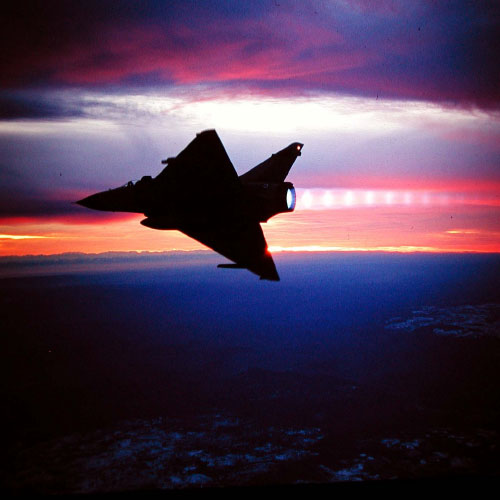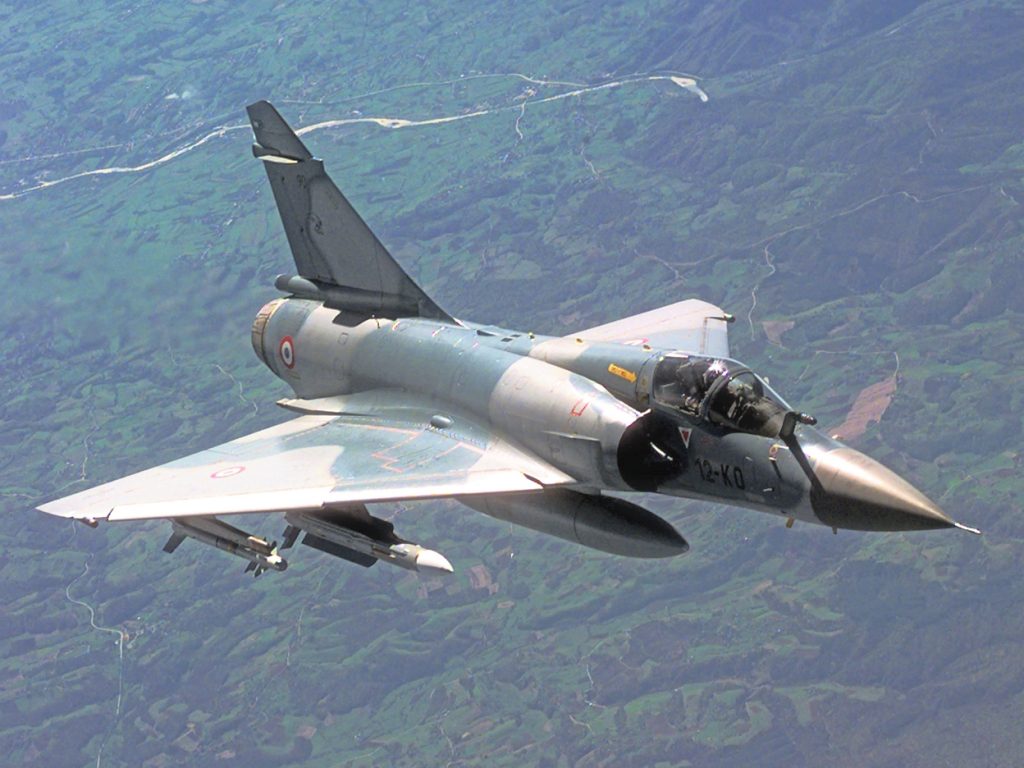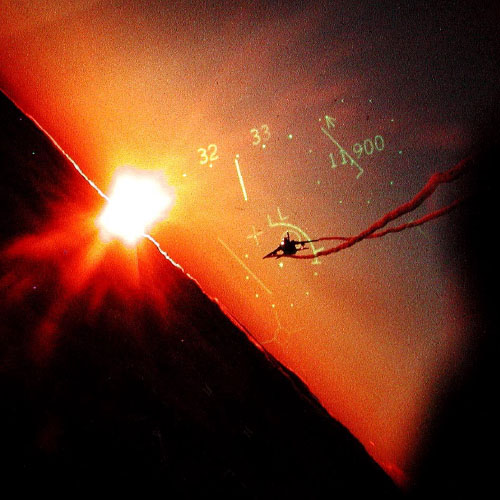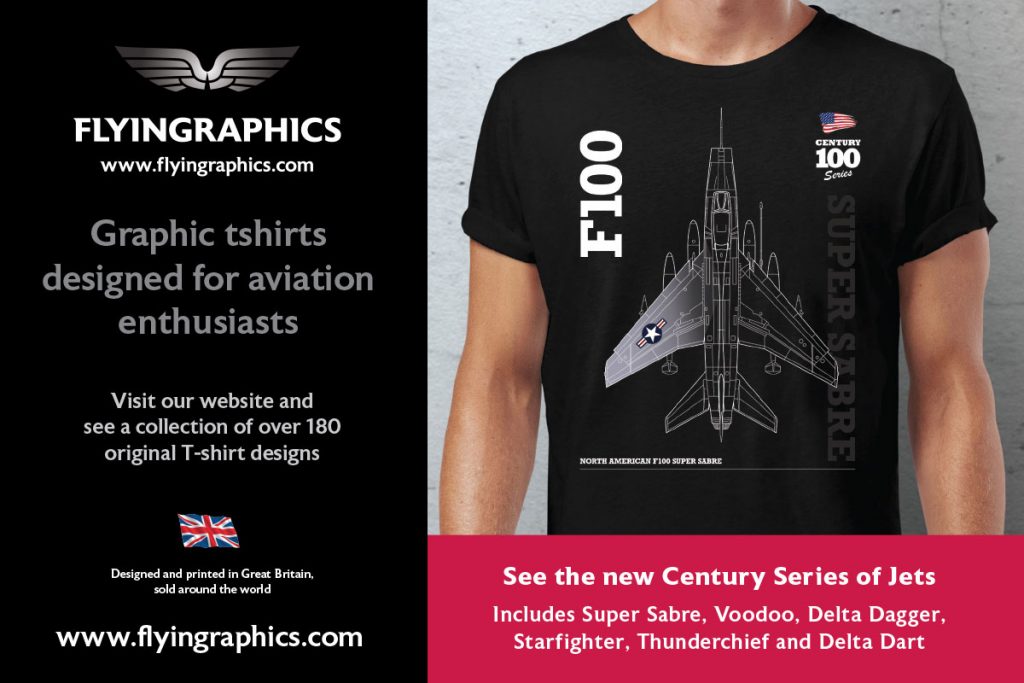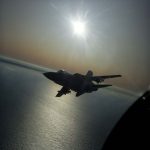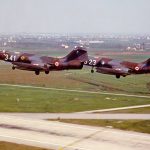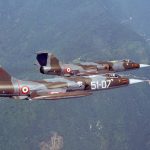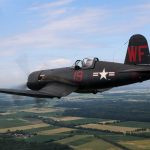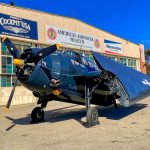Pilot Report: This another in our series of recorded flying experiences that we have received from readers and adapted for our website. We will publish further accounts from time-to-time, but are eager to record more for the future. If any readers are interested in sharing their own memories and stories with us, please do contact us HERE.
By Ian Black via Flying Graphics
Flying a war mission is like comparing a football player playing in the premier league to one playing in the world cup…the World cup is the ultimate kick. Having spent ten years as an English speaking Air Defence pilot it came as no small shock to find myself at night at 40,000 feet on my own in an aircraft belonging to a foreign Air Force, worse I was speaking French and slung underneath it’s belly were two 500 pound bombs that were in my opinion about as much use as zips on socks to an Air Defence pilot. Coupled to this was the fact that less than a year before I didn’t speak a foreign language nor did I know how to fly the French Mirage 2000. Our Squadrons mission was Close Air Support with a secondary role of Air defence, the new “buzz word” is Swing role or the ability to switch from dropping bombs to shooting down other aircraft whilst airborne.
12 months previously I had been posted from my normal job as an RAF pilot to exchange duties in the South of France with the “Armee de L’air” The French Air Force. Within 4 months of joining my Squadron we were sent to Italy as part of the multi national force involved in operation “Deny Flight” policing the skies over war torn Bosnia Herzegovina. By the time I arrived in Italy, our forward operating base the operation had been in progress well over a year. The war was in American speak a “low tech war” almost medieval by modern terms hand to hand fighting between groups of people who had once been neighbors. New headlines filled the tabloids; “Ethnic cleansing” became a household phrase hyped by enthusiastic journalists. Our role was not to attack these people, for there was no apparent enemy, our job was to police the skies preventing an escalation of war by denying the two sides the use of air power.
Unlike the Royal Air force who had chosen to base their aircraft in the South of Italy the French had wisely chosen the airfield of Cervia. Stuck smack bang in the middle of the Italian Riviera it was perfectly situated, from a pilot’s point of view anyway. Off duty it was beaches, nightclubs and the occasional glance of some very pretty women whilst airborne it was boring holes in the sky day and night over Sarajevo CAP (Combat Air Patrol) became a dreaded three-letter word.
Our first day in theater was spent in traditional military fashion – death by view foil a constant barrage of briefings, interspersed by an equally constant tidal wave of Coffee. By the end of the day with our first attack on the Italian Pasta mountain deemed a success every one began examining the inside of their eyelids staying awake became the main aim of the day. Our last briefing of the day concerned CSAR (Combat Survival and Rescue) entering the room was a diminutive figure who somehow reminded me of Odd Job a character from the James Bond movies. I imagined the New York police Department describing him as “Male white Caucasian about 5”4’ 180 pounds, oh yeah and built like a brick out house”. This man of Lilliputian size was “Mr Muscle” he had no neck his head was simply attached to his shoulders my immediate thoughts were “this boy needs to go easy on those steroids”. It was comforting to know that if I were forced to eject “Mr Muscle” would come and get me, in fact I believe he wanted me to eject just to go and legally be allowed to “kick ass”. The procedure for rescuing downed airmen is to say the least a complex one built on some hard learnt lessons from previous conflicts; it’s also highly classified. The days of meeting a friendly resistance farmer who hid you in his hay stack, fed you let you drink his best wine then let you sleep with his daughter before handing you on to friendly agents has sadly gone. Reality is evading capture in enemy territory run by people who think the Geneva Convention is a Swiss Banking association. Today’s wars rely on you waiting for the big black gozzomi bird to find you at night and snatch you to safety. As far as procedures go all I can say is that they’d arrive by night with out lights or radio in a Helicopter packed with more firepower than then British Army of the Rhine. The American Special Forces and their counterparts are fortunately extremely good at what they do. I have no doubt in my own mind what I’ll do if I get shot down. If anyone threatens me I’ll shoot without hesitation. Chances are when they find out I’m British and my aircraft is foreign they’ll think I’m a spy and kill me anyway. I’ve a pretty good idea that they probably won’t kill me with a lethal injection after my last dying wish (Tall blond and without vices). Therefore I have to protect myself. If all else fails I’ll save just one bullet….for myself.
Briefings complete and after a familiarization mission with an experienced pilot you’re let loose flying subsequent missions as leader or wingman.
Flying in pairs is vital to provide mutual support and increase firepower. Our mission in question is for the early evening/ night and starts the following day. A computer disc arrives at the squadron containing the following days “Frag”, a fragmented version of the entire days operation. By sifting through the myriad of figures we can extract every piece of information we need to complete our mission. It also allows us to see the details of every one else’s sortie, handy for locating air to air refueling assets and to see which other friend lies will be airborne at the same time. All the relevant data pertinent to your sortie is then transferred to your mission data card, which you carried on your knee for quick reference. Our mission is Close Air support followed by Combat Air Patrol after dusk total flight time 5 hours including two airborne refuels.
On the day of the mission about an hour of the day is spent getting dressed preparing for the worst. It’s a strange feeling to put on a set of cloths with the constant thought that they may not be coming off for several days or weeks, not to mention the personal hygiene considerations! Posters decorate most RAF changing rooms with the picture of a poor chap unsuitably dressed for an English winter about to go for an unexpected swim in the North Sea, “dress to survive” is the motto. Squashed into your personal dinghy are all sorts of escape and survival goodies but who’s to say they’ll still be with you after a 600 mile an hour ejection. In the back of my Combat life vest I stuff as many things as I can into any remaining space. Number one a Swiss army knife, the corkscrew is a must; imagine finding a bottle of wine and not having a corkscrew. I also stuff three folded black plastic bin liners, not to disguise myself as one of the homeless but to use in a survival situation. There must be a million uses for this innocuous piece of plastic, most importantly keeping things dry. I’ve squeezed in some spare batteries for my hand held GPS (Global Positioning Device) Without batteries I may as well try and shave with it. This is the ultimate survival tool .Our version the Trimble Scout is not much bigger than a Sony walkman but can tell me my position any where on the planet to within a few meters as well as a heading to take to a waypoint, and a host of other useful features. No more secret compasses hidden in shoes or navigating by the stars this is THE high tech gadget, the survival gizmo of the 90’s. In my leg pockets I have for some time now flown with two Mars bars and two Twix bars-emergency rations. They are now, after many missions, very definitely squashed beyond all recognition however having read the accounts of ejectees eating ants and worms after a few days in enemy territory I think I’ll stick to my dehydrated squashed chocolate bars. Finally I check my escape map another product no doubt of the NASA space program. It’s made of Kevlar a plastic type paper which is tear resistant .On one side is a go anywhere tourist map of the war zone and on the reverse is a collection of hints for happy campers. Amongst them a list of Flora and fungi that are edible and a section on 1001 uses for your “Kevlar” escape map. I’m mildly amused by the paragraph on how you can use the map, scrunched up into a ball to plug a large shell induced flesh wound. Make with old things episodes. Having donned all our flying kit we walk through to Ops and collect our 9 mm pistol with it’s 40 rounds of ammunition, as far as I’m concerned it has two uses either throwing at the enemy or using on myself when it looks like I’ll taking a leading role in the all new Serbian “Boys from the locker room movie”. I have for some time gone through the scenario of what I’m going to do if I eject. First of all I’m not going to get caught, under any circumstances. I’ve talked at length to a friend who was taken prisoner in the gulf war. I never thought of putting lighted tissue paper down the back of my flying suit was the way forward. We are all trained in resistance to interrogation. Name rank and number is the age-old phrase. Give them the slightest bit of information and they’ll work on opening you up. Never ever sign for anything and if they offer you food take it first then wait for the kicking! I was once caught during an exercise and hooded up then thrown in the back of a lorry. My disappointment of being caught soon changed when I realized my very unfriendly SAS man had left his pack lunch by me. Lifting my hood enough to push the soldiers mars bar and sandwich in my mouth it was my first proper food for 5 days. Needless to say I’d not recommend to anyone stealing an SAS soldiers pack lunch. If I do eject at least I have it clear in my own mind what my escape plan is, I don’t dwell too long on the subject.
My leader and I walk the short distance to our assigned aircraft. A shimmering heat haze envelopes the line of sleek potent Mirage fighters everything about them looks right, even the light blue paint scheme seems cool in a world of grey colored warplanes. I climb the ladder weighed down with the extra equipment I carry. I fit another portable GPS onto the cockpit coming, and place a mound of maps down the side of my Martin Baker Zero-Zero ejector seat. In order to avoid collateral damage navigational accuracy is crucial if we are tasked to drop live ordnance. Living up to it’s name as the Ferrari of fighters the cockpit is equally small very much a case of being a bit tight around the shoulders. This is however to be my office for the next 5 and a half hours. Having carefully strapped myself onto my rocket-assisted seat I glance at my data card which shows we are 5 minutes to engine start. This allows me sufficient time to arrange all the switches in an eye pleasing manner and to coin a phrase “get all my shit in one sock.” My leader calls me on the radio as the first spots of rain bounce off the canopy…. It’s going to be a long night. The weather forecast for our allotted period isn’t good with thunderstorm activity anticipated through out our mission. I lower, and then lock my canopy -no point in spending the next few hours soaked to the skin. The Instant I press my engine start button dials move lights flash and the dormant metal monster breathes life. All I can hear in my headphones is a slight crackle and the low methodical rumble of my jet engine breathing life into my machine. The Engine is the heart of the machine it provides power to all the services without it I’m defunct, and I only have one engine. I wave away the ground chocks holding me back and the jet lurches forward, even at idle power. I dab the brakes to kill my forward speed and check the system. The sky is coal black and I can hear the pattering of rain above my head, above the background noise.
As I ease past the line of Fighters I move closer to my leader. I’m looking down his jet pipe through its shimmering heat haze, partially obscured by the incessant rain that is now falling. I can just see a dim orange glow telling me his engine is running at around 800o C. No one watch’s our departure no one bids us farewell It’s raining too much.
We each take our place on the runway threshold, a wide once white slab of concrete now peppered with black rubber tire marks. I can almost touch my leader were sitting so close he gives me the hand signal to go to full power. I run my eyes carefully across his aircraft checking for leaks or armament pins left in place. This is no peacetime mission, to be unable to fire a missile because of a forgotten pin is inexcusable, and failure is not an option. I look ahead unable to see the runways end due to the sheet rain that’s now driving across the airfield. Under my fuselage are two 500-pound MK82 Iron bombs, two Magic 2 air-to-air heat-seeking missiles and 5 tons of fuel. I’m about to propel myself at nearly 200 miles per hour along this rain soaked strip of tarmac…. I must be crazy. My leader nods his head and releases his brakes as he rolls forward slowly at first, then the back of his aircraft erupts in an orange glow, the after-burner kicks in. I hit my stopwatch and wait 30 seconds. The second hand reaches the bottom and I release the brakes simultaneously slamming my left hand forward on the throttle to engage the reheat. I can feel a thump in my back as the burner lights, confirmed by a green light in the cockpit, this is the business. It’s at this precise moment that I understand why the quintessential defining moment in any fighter pilots life is a combat mission. As I reach my rotation point I fly into what can only be described as a steam cloud left by my leader as he torched the runway on take off. More by instinct than skill I ease back on the stick devoid of visual references. I can feel the main wheels part company with the runway and the aeroplane leaps into the dirty sky. Thirty seconds ahead of me is my leader so it’s essential we fly the same pre briefed speeds. If he fly’s slower than me or I fly faster than him there is a very real danger we’ll collide in mid air. The cloud tops are a gentlemanly 4000 feet above ground and I quickly spot my leader, ahead of me by about 5 miles. As soon as I break cloud the seeker head of my infrared missile searches for the warmest heat source. Despite it being in a safe condition i.e. if I pull the trigger nothing will happen the head locks onto my leaders jet pipe and a low growl rumbles through my ear phones assuring me it’s acquired it’s target. In my head up display a small green circle appears around his aircraft to show me where to look, with visual contact now I’m happy. To close the gap I nudge the throttle the Mirage pulses forward accelerating towards my leader. My job as his wingman is to stay in position and watch his tail. Despite having flown many missions as leader we are both experienced pilots and have decided to take turn and turn about as leader today my job is “wingman”.
We’re climbing quickly, despite the Mirage’s heavy war load the aeroplane could still carry lots more stores or extra fuel tanks. Below us lies the warm inviting Adriatic Sea, now at it’s peak summer temperature and considerably warmer than the murky grey cold North Sea. As we approach the Croatian coast we leave the Italian radar controllers and contact “Magic”. I presume the AWACS is universally known by the call sign as “magic” as that’s basically what it is. High in the sky this floating radar station is the all seeing eye like some giant viewing device watching the world .The ultimate camera obscura On board the AWACS are men from around the world each playing their part in this complex jigsaw. We establish contact using a code system; this ensures we are talking to the right people and not some enemy ground station ready to give us spoof information. Our mission details are confirmed as we head East across the Croatian coast line. Below us expensive Yachts probably stuffed full of German tourists soak up the last of the days sun. You can almost see the Beach towels going down to reserve tomorrow’s place whilst less than 100 miles away a civil war of barbaric proportions is underway. As we cross the innumerable tiny islands that make up this exquisite coastline we call “feet dry” signalling to the AWACS that we are over land. High above two long white pencil lines tear the azure blue sky. It’s our predecessors on combat Air Patrol homeward bound after their five hours in the box. We cross beak to beak as each pilot in turn rolls his aircraft upside down, safely several thousand feet above. It’s like the V sign gesture as if to say “we’ve done our job now get your backsides over there were off”. Our first landmark slides past my left wing, Udbina airfield. On the ground I can clearly make out Serbian J22 Oraos, a fighter-bomber aircraft which compared to the Mirage 2000 is positively prehistoric. The attack on the Bosnian Army’s 5th Corps headquarters, by these aircraft in November 1994, plus a subsequent attack on an ammunition factory in Cazin illustrates how the dormant situation can change overnight. The United Nations response to these raids was both swift and overwhelming- 30 allied fighter bombers from five sites struck the very same base at Udbina, now in the newly declared Serbian state of Krajina, in a single attack that lasted two hours. This served as a timely reminder to the world at large, and particularly the Bosnian Serbs just how serious NATO takes it’s role in operation Deny Flight.
As we reach the “box” or the Bosnian airspace designated as a no fly zone AWACS calls us reporting a slow moving target heading westerly at low altitude. Coupled to this is its position relative to a Bull’s-eye point. This is a common geographical or fictitious point common to all friendly aircraft. AWACS can give positions of hostile targets relative to this point, allowing all friendly aircraft to have an air picture of where the high threat is. In the old days targets were merely given as a range and bearing from the fighters nose. This is fine for one aircraft but useless for mass formations of fighters taking up huge volumes of sky. Our target is about 100 miles to the East of us, a quick check of the fuel confirms that we’ve enough to complete the intercept and have a reserve. Double-checking the entire weapon switches are in the correct place we start to separate. This allows me to look in my radar with out fear of collision. One of the cardinal rules is never stick your head in the cockpit for more than a couple of seconds. It’s the same as driving a car on a motorway, trying to read a map and eat a sandwich at the same time, all of a sudden it hits you that you’ve been looking inside too long, you look up confronted by a face full of Juggernaut.
I can hear the controller in the AWACS’s voice start to change he’s as concerned as I am that we don’t screw up. Against us could be a helicopter or a group of slow speed bombers, at present all we’ve been given clearance to do is “Identify” no one has yet said “Engage”. Rushing towards a target with 700 miles an hour of closure things tend to happen very quickly. The elasticity of time and time compression become all too real. We are approaching the contact area and neither of us has any contact on radar. It’s probably a helicopter, low down and low speed. Our radar which is optimised for the high-speed threat is not suited to this type of attack. We are now over the exact position AWACS is telling us where the target is, searching feverishly the sky remains clear. I am actually aware of how dangerous the situation has become. It could be a trap. Down below Serbs could be running through a checklist to launch a surface to air missile at us. I watch like a hawk, scanning inside and out, my hand on a hair trigger. I may go into an idle power break, drop chaff punch out flares, go low. The situation is fluid and I prepare for the worst. We set up a complex figure of eight pattern in order to remain over the exact spot and search the sky from all angles. We are directly above a small hamlet even from 10,000 feet you can see some of the buildings are burnt or damaged. A river cuts the town in two and close to its banks is a football pitch. Suddenly the penny drops the reason why we can’t see anything on radar is because the target is on the ground. The unmistakable shape of a Russian built Hip helicopter squatting on the turf disgorging its cargo is what we are looking for. The transporter is not camouflaged but a dirty white and blue colour marked faintly with two Red Crosses. I doubt very much that it’s carrying medical supplies for refugees or aid workers. More probably a Serb general and his Hench men brought in for a meeting away from the prying eyes of the United Nations in Sarajevo. We photograph the violator of the UN Resolutions and make our report to the AWACs, whether anything will come of it is anyone’s guess. This is the frustration and helplessness of the job, all this effort for what result. Perhaps we have reduced the escalation of War but we certainly haven’t prevented the mass graves and numerous atrocities so openly publicised in the Sunday papers, ours is not to reason why. My mind wanders momentarily, people leading wretched lives, children with no father, no future, what hope.
With our fuel reserves rapidly dwindling we need to head for the tanker, further more the weather is clamping in. huge cumulus clouds tower above us. We climb higher to avoid the violent turbulence associated with these giant floating cotton wool balls. The sun is setting in the west bathing the clouds in an eerie orange and yellow glow. The sky is divided between dark blue -black bands on top a yellow orange band for the horizon and dark ready brown below. As the sun goes down thin traces of red light dart across the ground. As tracer fire marks the spot of a ground battle waging below us. Suddenly life at 30,000 feet in a warm cockpit seems the place to be.
With less than 60 miles to run to our tanker we make all our weapon switches safe. Ahead lies a wall of solid cloud towering into the stratosphere. We execute a jink to the right in an effort to find clearer weather but to no avail. Normally we don’t need to talk with the re-fuellers but this is becoming desperate. We ask him what the weather is like at his level. His reply is not the one we’re waiting for, firstly he’s late, trying to avoid weather has put him miles of course and secondly he’s in the middle of a cumulo nimbus cloud, colloquially known as a cu nimb. My radar has a contact well to the left of my nose at a range of 50 miles, a quick call to my leader and AWACS confirm this is our floating gas station. I select my radar off and close up on my leader. The power from my radar whilst it’s operating could fry a beef burger at 10 yards, which is roughly the distance I’m away from my leader’s nether regions, best I leave the Radar off. In the twilight all I can see of my leaders aircraft are his luminescent formation lights and the glow from his cockpit. As I tuck close onto his wing I know he’s trying his damnedest to be as smooth as possible. Although we of different nationalities I have a huge respect for him besides which he’s from Corsica and they get my instant respect. Flying close formation by day is tricky enough, flying it at night and in cloud concentrates the mind. I’m concentrating too hard to look for the tanker but my leader does an impressive job and rolls us out neatly behind the flying fuel tanker. I ease out slightly dividing my attention between the leader and the tanker. He asks me my fuel and determines I’ve about 5 minutes worth less than him and therefore I get to tank first. This must be the hospital pass to end all hospital passes. I slide gingerly under my leader taking the lead and positioning myself for the re-fuel. We are just in-between cloud layers and the turbulence is horrendous. At the back of the refuelled is a large 30-foot metal boom dangling in the air, it’s bouncing up and down like a yo-yo only much faster. At the same time I’m being tossed about like a small doll. Somehow I’ve got to make this mutual bouncing up and down meet at the same time with my refuelling probe in the metal basket attached to the boom. In different circumstances and after a candle light dinner this might be a lot of fun. Right now I’m positively and genuinely concerned for my well being. I’m aware of an eerie glow dancing around the edge of my canopy a mauve bead of light flickers across the arch, St Elmo’s fire. As if I hadn’t enough to worry about. The added attraction of a bit of stray electricity as you take on fuel at high pressure at high altitude and at high speed is not what I’ve requested ’. We sit under the tankers wing as he flashes through the night sky waiting to offload his fuel. Once cleared behind the tanker I gingerly slide my aircraft under the leader and take up a position astern the boom. Attached to the end of this long metal joust is a steel basket about 4 feet across, this is my aiming point. Right now all I can see is the basket a blur as it bobs up and down.
In situations like this I’m wary of the fact that 12 months ago A Mirage 2000 from the same unit ended up in a watery grave “ somewhere in the Adriatic”. The pilot Captain Tom V**** was flying his first Deny Flight mission, indeed it was the very first French participation in a Deny Flight mission. In conditions similar to the present he arrived behind the tanker to take his fuel. Once behind the basket he moved forward in an effort to make contact. The basket oscillated violently, crashing down the side of his fuselage. His engine with catastrophic results ingested particles of metal. The man who sits in the back of the tanker controlling the operation saw Captain V***** immediately drop back. His engine lost power immediately, a huge sheet of flame leapt from the jet pipe as the pilot vainly tried to rescue his doomed fighter. With a total loss of power ejection was his only option. Pulling the black and yellow handle between his legs he was immediately catapulted into the night air. By chance he landed in the Adriatic close by a passing French destroyer and was rescued unharmed. Despite his traumatic ordeal he still managed a joke with his wingman. Sitting in his one-man lifeboat his wingman called over the radio to see how he was doing, “just swimmingly” came the droll reply. With these events uppermost in my mind I position my aircraft as close as I dare. I can see the metal basket just a few feet from my face illuminated in a warm red glow. Without warning the metal basket slams down onto my Radome causing the aircraft to shudder I ease back fortunately undamaged. I check round the cockpit, my eyes glued to the jet pipe temperature gauge and RPM. These will give me my first clue of engine failure. All is well but it’s clear we were not going to make contact in these conditions. Running out of fuel and ideas we have no option but to return to base. Having thanked the tanker crew for their efforts we part company and head for base.
We were now in a catch 22 situation with barely enough fuel to get home let alone divert we still have to get home pronto. Flying fast will use up even more fuel than if we flew at an economic speed, but we have to beat the approaching thunderstorm. Fortuitously our home base is only about 15 minutes flying time away, and as long as we keep our speed at around 500 M.P.H. should beat the advancing storm. We head north; below us the twinkling lights of the Italian coast it’s people oblivious to our predicament. Life is surreal in a jet cockpit cocooned from the real world. It often takes a positive effort not to become detached in aware of what you are doing. Sitting on an aluminium rocket cutting the sky at just under the speed of sound. Just before I close up on my leader I recheck that all my weapons are selected off prior to landing. We contact our home base control tower who tells us that we’re clear to join but to be aware the runway is flooded. This means the length of concrete we have to land on is covered in standing water. This renders our brakes virtually useless and we must rely on a brake parachute fitted under the rear of the aircraft. Sadly our only hope of a safe landing, the arrestor hook is not fitted to our aircraft. We have a choice hook or chaff and flares, we have chaff and flares. Should this fail I’ll have serious problems coming to a halt. As soon as we cross the runway threshold my leader breaks hard away from me. One second I’m in close formation struggling to stay tight. Next I have a face full of Delta wing ripping away from my pull. Mildly perplexed as to why he should attempt so punchy a break at night I look ahead to see the other end of the Airfield is being bombarded with rain by the biggest thunder cloud I’ve ever seen, good decision to break early. I count three potatoes and throw my aircraft into a cruelly tight turn. I figure it’s the only way to kill my speed and have a chance of landing before the runway threshold goes out in rain. I pull 6 “G” and then squeeze to 8, I can feel my lower body being compressed as my anti “G” suit, wrapped around my legs, begins to inflate. Without this piece of clothing I’d very soon be blacking out. My airbrakes are out my throttle idle, I’m bleeding speed faster than ever before. Limiting speed arrives and I select airbrakes in and chuck the gear down. No time for finesse. Ahead I can just make out my leader as he turns onto his final heading making a beeline for the runway. It seems like an age but is probably only a few seconds before my turning point arrives, as I look towards the field I’m blinded by a flash of light so intense my mole like vision is destroyed. From an inky black night the sky is transformed into day as if a giant switch has suddenly been flicked on. I can see a massive fork of Lightning stab the ground and turn the surrounding area a bizarre mauve and purple colour. It must be illuminating an area of about 30 square miles and I am transfixed by this wonder of nature. My leader calls he’s down, which triggers my brain into reality. I’ve been watching this strange phenomenon too long transfixed by its awe. I bank my aircraft harder aware that I’ve gone too far from the airfield. Night landing are a real hit and miss affair, some are smooth and others well suffice to say they’re more of a controlled crash.
Passing over the runway’s end I close the throttle and await the inevitable, surprisingly it’s quite smooth. Instinctively my left hand reaches forward to pull the brake parachute, a reassuring tug lets my senses know it’s deployed. My landing light shines down on a flood of water, which is being sprayed up towards me with a tremendous force and lashing against my canopy. My speed is still in excess of 140 M.P.H. I dab my brakes in an effort to arrest my forward motion. My feet press down on the two brake levers with seemingly little effect. My aircraft is aquaplaning and to make matters worse my forward view is now totally obscured as I hit the edge of the rain. All I can do is maintain the runway heading or I’m certain to vacate the concrete sideways left at an unholy speed. The wind is buffeting my aircraft, the brake parachute exacerbating its effect. The end of the runway is approaching fast and I try my brakes once more, tantalisingly they bite only a little but enough to make my aircraft decelerate. As I glance ahead the runway turn off point looms apparent. I calculate at my present speed I can just turn off without careering sideways into the mud. With a deft dab of rudder the Mirage arcs round the narrow taxiway its Dunlop’s biting into the rain sodden tarmac. To one side is a small parking area where the ground technicians disarm my aircraft. Their task complete I taxi back to the flight line that I’d left some 4 hours previously. Shutting down my engine it suddenly comes home to me what I’ve been through, all in a days work perhaps, thank goodness not every days like that or perhaps I’m just a man who likes his job. Again I know I’ve just experienced that quintessential defining moment in a fighter pilots life.
Article sponsored by Flying Graphics
Pilot Report: This another in our series of recorded flying experiences that we have received from readers and adapted for our website. We will publish further accounts from time-to-time, but are eager to record more for the future. If any readers are interested in sharing their own memories and stories with us, please do contact us HERE.







